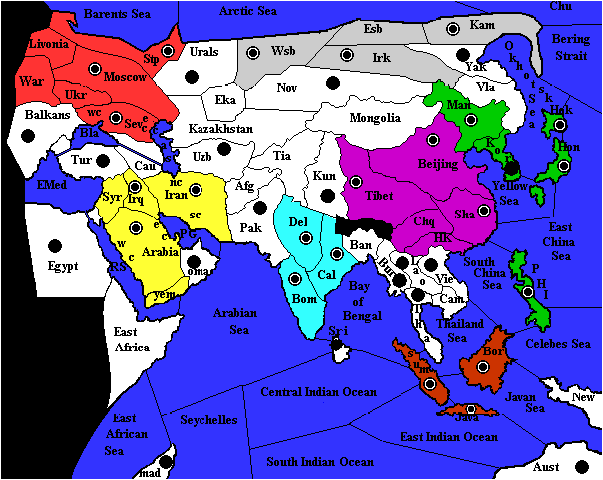



|
Pitt Crandlemire
The
|
From the judge info.asia file:
There are absolutely no rule changes from the standard Dip rulebook. Just a new map. [...] Asian Diplomacy has almost no historical basis. However, it is very well-balanced, which should be the final criteria for a wargame. All powers have equal chances to win.Well, that doesn't tell you much (and what it does tell you is, unfortunately, inaccurate). So, let me try to paint a clearer picture.
Major map landmarks include two landlocked seas, the Black Sea and the Caspian Sea, both in the west, separating Russia and Persia and linked by a canal through the Caucasus. Additionally, the Himalayas (impassable) are centrally located and divide India and China.
Significant areas of neutral SC's are Southeast Asia (Bangkok, Thailand, Laos, Vietnam), Australia (Australia and New Guinea), The Stans (Pakistan, Uzbekistan, Tien Shan, Novosibirsk), and the Mediterranean (the Balkans, Turkey, and Egypt).
Here is the map for the variant.

|
|---|
| Russia | starts in the northwest corner with A Mos, A Sev, and F StP |
|---|---|
| Persia | starts just south of Russia, along the center of the west edge of the map with A Irn, A Irq, and F Ara/ec |
| India | starts just south of the center of the map with A Cal, A Del, and F Bom |
| Indonesia | starts in the southeast corner with F Bor, F Jav, and F Sum |
| China | starts east-center (just north and east of India) with A Bjg, A Tib, and F Sha |
| Japan | starts just east of China, along the center of east edge of the map with F Hok, F Hon, A Man, and F Phi |
| Siberia | starts in the northeast corner with A Irk, F Kam, and A WSb |
With Japan, Siberia must resolve the status of the Novosibirsk and Yakutsk SC's. Japan's Manchurian army is pretty much powerless without support from Siberia or China. However, it can wreak havoc with Siberian lines if it's not controlled. Moreover, Siberia must worry about the activities of the Japanese Hokkaido and Honshu fleets. If they both head north, Kamchatka is threatened. All of this is unlikely, however, with just a bit of willingness to compromise on Siberia's part. Typically, Japan agrees to stay out of the Bering Strait, takes Yakutsk with a fleet, and holds the Manchurian army while Siberia picks up Novosibirsk. Also, typically, Siberia stabs Japan in 1902 with Chinese aid, especially if the R/S alliance is in effect.
Since, almost without exception, the smart Russian and Siberian players will form an early alliance, Russia is left with one other path for expansion - namely, south and southwest through Persia and the Mediterranean. Alternatively, Russia can choose to sit back, take the guaranteed Balkans SC, sweet talk Persia, and wait to see what develops. Russia can afford to do this since his corner position is quite secure unless he is besieged by both Persia and Siberia. So long as the Russian secures a solid alliance with one of those powers, he is in good shape through the mid-game.
As a result of this imbroglio, Persia must make every effort to woo India unless he has a rock-solid alliance with Russia. Typically, this is not very difficult, since India is normally focused eastward. The only potential sticking points are the Pak and Uzb SC's, both of which border Irn, a Persian home SC. Since Persia normally needs the Irn army to protect Cau from Russian encroachment in spring 1901, the usual agreement is for Persia to take Pak in fall 1901, then swap Pak to India in 1902 in exchange for support into Uzb. A normal stipulation is that India will vacate Pak in 1903, leaving it vacant thereafter.
As noted above, India is almost certain of gaining a Persian ally, so his only remaining early concern is Indonesia. Happily, that's not likely to be a problem in 1901 since Indonesia is more likely to be concerned with grabbing the plethora of available SC's in Australia and Southeast Asia. In 1902, however, things tend to go sour for India and Indonesia is the usual culprit. It's not uncommon for Indonesia to get three new SC's in 1901, giving him six units in 1902. That means he's almost certain to have five fleets and it's a foregone conclusion that several of them will be heading towards Sri and Ban. India has the ability to respond by building two fleets in winter 1901 but, if he does, he virtually cedes all future northern expansion in The Stans to Russia, Siberia, and China. Moreover, his fleets will be acting in a purely defensive fashion, while Indonesia is likely to still be grabbing one or more new SC's.
India's only hopes for long-term survival are a strong Persia building fleets to use against Indonesia or a strong China or Japan doing the same. Without a seaworthy ally to aid against Indonesia, India is ultimately doomed.
Indonesia's only down side is that it's likely to be very difficult to get a solo. Given his need to build many fleets early, he will find himself army poor when it comes time for the land war through India. Moreover, the ease with which Siberia or Russia can shut off the northeast corner (Kamchatka and Chucki Sea) means that Indonesia can't gain any ground north of Japan without armies, too. The smart Indonesia player must make the most effective use of his fleets early and plan on an army campaign in the mid-game in order to get a shot at a solo.
Ideally, China would enter into alliance with Japan and the two would put a serious crimp in Indonesia's plans. However, this rarely happens due the extreme close proximity of their units, home SC's, and target neutral SC's. Complicating this further is that a C/J alliance will be pressured from both the north (Siberia) and the south (Indonesia). Even when C/J alliances form early, the strain on them is so great that they rarely last past 1902.
China does have one possible longer term ally, however, in Siberia. Should the two ally early, China will get Japan's Man SC, as well as Vie or Lao. China then has to go full bore after Japan, eliminating the island nation before Indonesia comes steaming north. The chances of success are slim but they are better than most of China's alternatives.
Here's the deal. Japan has no guaranteed access to even one neutral SC. Indonesia can (and most likely will) block access to New Guinea. China will do the same to Vietnam. Siberia can do the same to Yakutsk. In order for Japan to even get a build in 1901, he will most likely have to resort to the threat of hostile action, e.g. to Siberia - threaten Kam, to China - threaten Bjg or Sha. Those powers must cooperate if Japan is to get a build. The really bad news is that they are much more likely to cooperate with each other to take a Japanese SC, not give one. Worse yet, even if they do allow Japan to get a build, they'll be in better position to steal it back in 1902 than Japan will be to defend it. Japan's only saving grace is that the sea spaces in the area (Bering Strait, Okhotsk Sea, Yellow Sea, and East China Sea) combined with his three fleets allow greater mobility and flexibility. However, this is essentially useless. Playing fleet shuffleboard may be fun but it accomplishes nothing except stalling and, sooner or later, Indonesia or Siberia or China will come calling and the game will be over.

|
|---|
So, there you have it. As it is, Asia is an enjoyable, if flawed variant. I have yet to play my suggested Asia Redux variant, however, so I can't promise that it's better. If there is sufficient interest, though, I will gladly GM a game to try it out. It's already been set up on a judge, so get in touch with me if you'd like to give it a go.
'Til next time -- whenever and wherever that might be....

|
Pitt Crandlemire The Big Dipper (pittc@syncon.com) |
P.S. One Free Pass to Big DipperWorld (all DipRides included; DipTreats cost extra) to the first reader who sends me an e-mail correctly identifying the pun in the title of this issue (plus your name in lights in the next issue).
If you wish to e-mail feedback on this article to the author,
click on the letter above. If that does not work, feel free to use the
"Dear DP..." mail interface.

